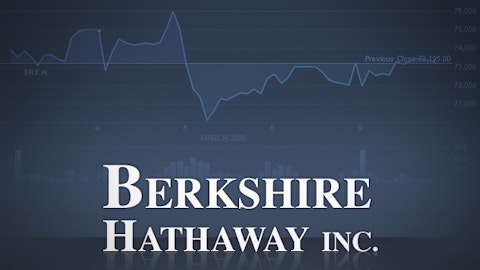
There’s certainly undeniable strength in those figures; however, it’s just not that simple. There are, in fact, two scenarios where buy-and-hold investing may not be your best recourse and could actually be downright detrimental to your portfolio.
1. Capital intensive businesses
Capital intensive businesses are ones that require a huge investment to turn what is often a marginal profit at best. Perhaps the poster child for high capital investment industries is the airline sector.
In order to be profitable and make a difference, airlines are required to purchase sizable fleets to service multiple markets. Unfortunately, airplanes aren’t cheap and this usually requires providers to go deeply into debt in order to finance these purchases. US Airways Group Inc (NYSE:LCC), for instance, declared bankruptcy twice last decade and even today still boasts net debt of nearly $2.4 billion.

Source: Jun Seita, Commons.wikimedia.org.
United Continental Holdings Inc (NYSE:UAL), made up of a merger between United and Continental, was brought about to realize cost synergies and better compete against larger national carriers. Surprisingly, though, as my Foolish colleague Adam Levine-Weinberg points out, the United Continental Holdings Inc (NYSE:UAL) merger actually resulted in extra costs last year rather than savings!
But it isn’t just airlines that long-term investors need to exercise caution with. Biotechnology companies are also capital intensive businesses as well.
It often takes anywhere between 11 and 14 years for a drug to go from a laboratory setting, through preclinical and clinical trials, to eventual approval by the Food and Drug Administration. In addition, the average cost of each approved drug, including all drug failures, according to Bernard Munos of InnoThink Center for Research in Biomedical Innovation, is approximately $4 billion. It takes a lot of money, a ton of research, and certainly a little bit of luck to get a drug approved, and even then that’s no guarantee that it’ll be a success. Factors like pricing, competition, and target audience also play into the eventual success or failure of a drug.
Dendreon Corporation (NASDAQ:DNDN)‘s castrate-resistant prostate cancer treatment Provenge is a perfect example of how pricing and competition can get in the way. Although its drug was easily approved by the FDA after delivering a four-month increase in overall survival, sales of Provenge, which runs $93,000 for the three-course treatment, have struggled because physicians are concerned about not being reimbursed for prescribing Provenge. Furthermore, competing drugs are cheaper on an annual cost basis.
Keep in mind this doesn’t mean all airlines or biotechnology companies are poor investments; it just means you have to be very picky with your research when it comes to investing in capital intensive industries.
2. Commoditized industries
There are two types of industries that are subject to commoditization and require investors to exercise more caution than usual: the technology sector and metals and mining.
The concern with the technology sector is that it’s always evolving. The time period between development cycles in everything from smartphones to laptops is shrinking to the point where there’s soon going to be no differentiable gap anymore. For the tech companies themselves, that could be great news, as it keeps consumers excited about potential new products. However, from an investable standpoint it’s terrible news because it creates high levels of competition and more efficient production lines that deliver a precipitous downslope in product costs.
Memory-chip maker Micron Technology, Inc. (NASDAQ:MU) is one such company that’s wholly dependent on demand from the PC and electronics industry, and is completely at the mercy of flash memory and DRAM prices. It can expand its production or reduce its costs as DRAM and flash prices rise and fall, but it doesn’t have the tools necessary to break the bonds associated with the cyclicality of the tech replacement cycle.
With regard to metals and mining, many of the same principles are in play. Spot metal prices have a propensity to move higher when the economy is expanding and pull back when it’s contracting, placing many spot prices in somewhat predictable peak-and-trough patterns, but making it very difficult to hold them over extended periods of time like a decade. Global gold miner Newmont Mining Corp (NYSE:NEM), for example, has delivered shareholders just a 75% return since 1988, because its demand can ebb and flow with the economy and it’s completely at the mercy of spot gold prices. Comparatively speaking, a 30-year U.S. Treasury note and the inflation rate would have netted you a better return over that period.
Also, many of the most commonly investable metals, like silver and gold, are used as electrical conductors in electronics devices, which, as I just noted, are easily commoditized. The natural evolution of the tech cycle has the ability to affect the demand for certain metals in both positive and negative ways.
Again, as with capital intensive business, this doesn’t mean there aren’t good long-term investments to be had in commoditized companies — they’re just much tougher to find.
Think long and prosper
The idea of pointing out these two scenarios isn’t to get you thinking short-term, but to get you to recognize that variations do exist and it takes more than throwing a dart to pick out a winning investment. Keep that in mind if these sectors are on your radar, but always remember that with regard to investing success, history is in the favor of the buy-and-hold investor.
The article 2 Scenarios Where Buy and Hold Rarely Works originally appeared on Fool.com and is written by Sean Williams.
Fool contributor Sean Williams has no material interest in any companies mentioned in this article. You can follow him on CAPS under the screen name TMFUltraLong, track every pick he makes under the screen name TrackUltraLong, and check him out on Twitter, where he goes by the handle @TMFUltraLong.The Motley Fool owns shares of Dendreon.
Copyright © 1995 – 2013 The Motley Fool, LLC. All rights reserved. The Motley Fool has a disclosure policy.


